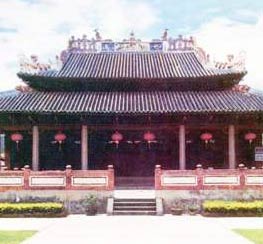
For people who want to know more about Chongming-the country's third largest island-the Chongming Confucius Temple is an ideal destination.
The temple, known to locals as "Xue Gong," or "Study Palace" in English, is an ancient architectural complex covering an area of about 1.55 hectares. It is the largest Confuciun temple in the city.
Originally built in 1327 during the Yuan Dynasty (1271-1368) it was rebuilt on the current site in 1622 in the Ming Dynasty (1368-1644).
For centuries, the temple has served as a place for locals to pay tribute to Confucius, considered one of the most influential figures in Chinese history.
As the founder of Confucian culture, the great philosopher and educator was revered almost as a spiritual being by millions of followers both during his lifetime and after his passing.
His ideologies include the five virtues of human duty-kindness, uprightness, decorum, wisdom and faithfulness.
Another of his concepts is that one should always put himself in another's place and not do to them what he does not want to be done to himself. Such philosophies have been passed down for generations and exerted a powerful influence on the Chinese population.
At the entrance of the temple are two ginkgo trees, both with a history of more than 600 years. Nearby are two large memorial archways towering overhead to show respect to Confucius and his views on education.
The structure, which is used as the Chongming Museum, houses historical and unique exhibits.
In Dacheng Hall, or the main hall, there is an exhibition on ancient boats.
Shipbuilding and water transport were fully developed industries in ancient Chongming.
For example, the large junk, one of the four largest wooden boat systems in ancient China, was invented in Chongming.
On display are the remains of two ancient wooden boats discovered around the city. They are said to have been built during the Tang Dynasty (618-907) and the Song Dynasty (960-1279) respectively.
Also on display are models of Admiral Zheng He's fleet that stopped at Chongming Island several times during voyages.
From 1405 to 1433 in the Ming Dynasty, Zheng, one of the world's earliest navigators, visited 37 countries around the world, some 80 years before Columbus' voyages.
It was regarded as the peak time in Chinese maritime power.
Zheng's adventure stimulated a number of important maritime inventions, such as central rudders, watertight compartments and various types of sails. At the time, it also demonstrated the power of Chinese civilization and yielded contact between the country and other nations.
At a nearby side hall is an exhibition chronicling the history of the island.
Located at the mouth of the Yangtze River, Chongming has a history dating back more than 1,300 years. Between 618 and 626 in the Tang Dynasty, two sand islands came into being at the site and later people started to inhabit them.
Since then, numerous sandbanks moved in many directions, eventually forming a big island-Chongming (meaning "land above water")-during the Qing Dynasty (1644-1911).
One hall features relics discovered on the island from different dynasties. They include the famous "Tang San Cai" pottery from the Tang Dynasty, bronze articles from the Song Dynasty as well as porcelain and jade works from the Ming and Qing dynasties.
Also on display are statues of famous figures in Chongming's history and a brief introduction to their contribution to the island.
Another exhibition, held in Zunjing Pavilion and Chongsheng Hall at the back of the temple, highlights the folk customs of Chongming people.
The surrounding area is full of traditional shops, such as a wine store, a fabric store and a drugstore. Each is staffed by wax figures.
Chongming Confucius Temple
Address: 696 Aoshan Road, Chengqiao Town, Chongming Island
Opening hours: 8:00 am to 16:00 pm from Tuesday to Sunday
Admission: 10 yuan
Phone: 6969-6655, 6969-3827
Getting there: Travel Bus Line 5 (Shanghai Stadium)-Baoyang Dock-Nanmengang Dock; Bus 51(Baochang Road)-Wusong Dock-Nanmengang Dock
(Shanghai Daily)
|

